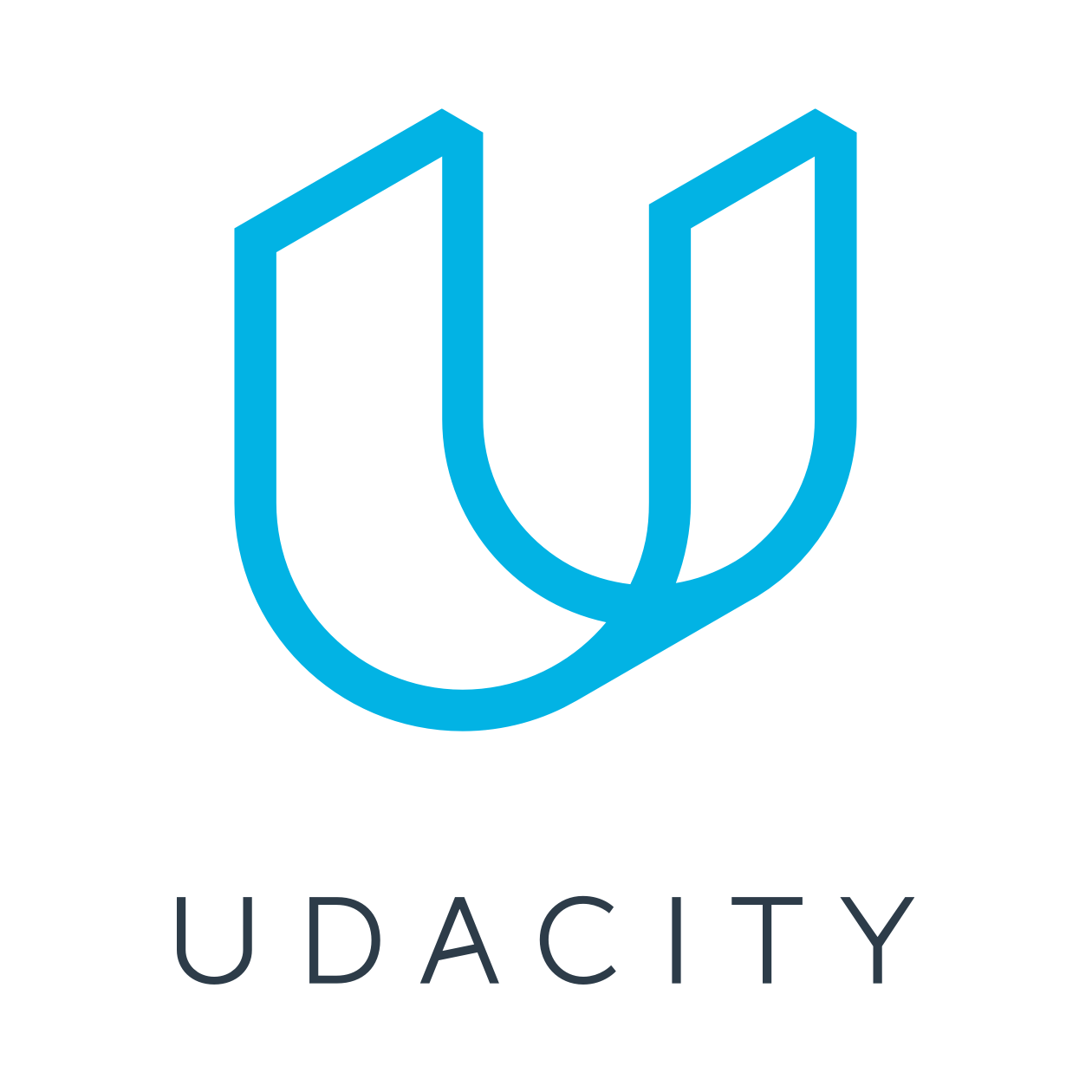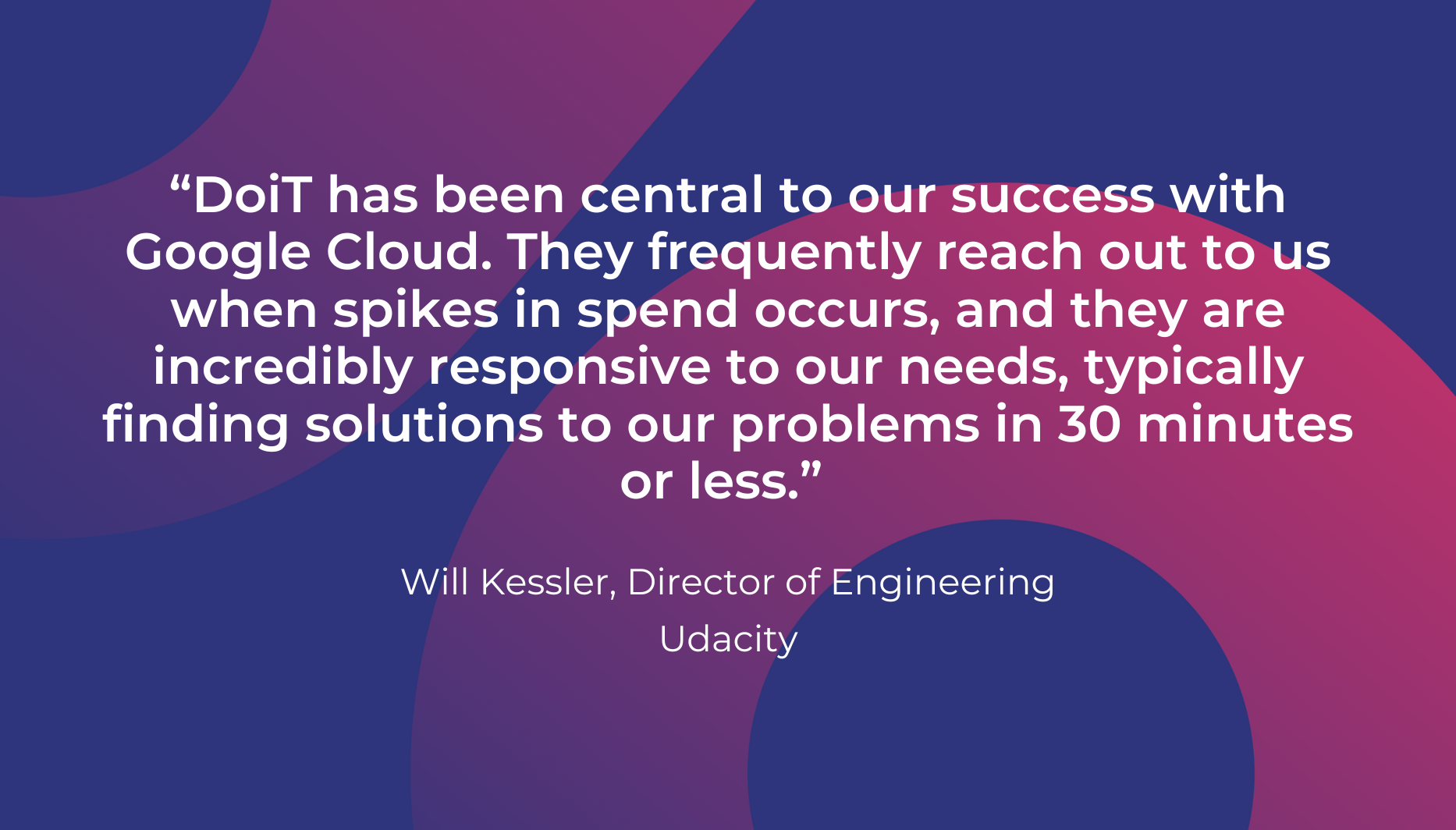How Felix Pago used DoiT Cloud Intelligence™ to reduce cloud waste and scale responsibly
Felix Pago used DoiT Cloud Intelligence™ to cut Firestore costs by 70% and align engineering with real-time, intent-aware cloud financial insights at scale.
Meet the team leading DoiT
Hear what’s new at DoiT
Unlock revenue through expert partnerships
Discover career opportunities
Award-winning partners of cloud providers


Technology changes constantly, requiring IT professionals to keep their skills current if they want to keep pace with an unending flow of new business challenges and opportunities. Fortunately, the quality and availability of online classes today is better than ever and provides busy people with affordable, flexible options to build their skills.
Udacity, a technology-focused online learning service provider, was built by education and IT industry leaders who wanted to pass on their real-world expertise. Through industry partnerships and career-oriented courses, Udacity offers highly relevant coursework aimed at training the world’s workforce in the careers of the future.
“As many people in the Education Technology community know, online learning can be a lonely experience for some students,” says Will Kessler, Director of Engineering at Udacity. “Udacity distinguishes itself not only by having high-quality, expert-curated content, but also by providing students with a lot of support by way of mentorship, immediate feedback on projects, and career guidance.”
Course modules and relevant labs are created, accessed, and completed using multiple virtual machines (VMs), creating complex, diverse compute demands. Udacity serves between 50,000 and 60,000 students whose support requires the use of 100,000 to 200,000 VMs every day. To provide highly-reliable services and manage enormous fluctuations in demand, the company turned to Google Cloud and partner DoiT International.
Maximizing efficiency of cloud spend
The ability to manage surge capacity is vital for Udacity to ensure the best student experiences. The company sometimes sees spikes of anywhere from 2,000 to 3,000 VMs accessed in minutes. Google Compute Engine powers the VMs, and Google Kubernetes Engine is built into the hypervisor infrastructure to assist with managing and maintaining systems, helping the company to handle surges with minimal or no disruption.
The company developed a custom auto-scaling solution that acts as a surge mechanism to instantly adjust pools of systems and maintain consistent availability. At the same time, Udacity needs to be extremely efficient with its IT spending to keep student costs low and be able to invest more into providing best-in-class educational experiences.
Given its heavy use of Google Cloud, Udacity turned to DoiT International to keep a close eye on spend and avoid potential waste. DoiT proactively informs Udacity when there are opportunities to reduce costs while maintaining the same functionality across compute resources.
For example, DoiT once noticed the tripling of SSD costs over just a few days, alerted Udacity, and discovered the issue was related to SSDs becoming detached and not properly deleted. “We had a bug and thousands of drives were being spun up, but no one would’ve noticed until we received a very large bill,” says Will.
Simple alerts such as this one underscore the ways in which DoiT helps Google Cloud customers maximize the value of solutions.
“DoiT has been central to our success with Google Cloud,” says Will. “They frequently reach out to us when spikes in spending occur, and they are incredibly responsive to our needs, typically finding solutions to our problems in 30 minutes or less. DoiT also lets us know about balanced persistent disks, which has saved us 75 percent on drives since making the change.”
Helping professionals and businesses through challenging times
Udacity offers nanodegrees as part of project- and skills-based educational credential programs that save students money and enable them to learn at their own pace. Throughout the pandemic, Udacity has seen large demand for nanodegrees that are the direct result of people wanting to learn skills that will enable them to continue earning income while working remotely. At the same time, Udacity has seen its platform used by businesses to help retain employees by providing more opportunities for growth.
“We’ve seen that, surprisingly, people are more apt to make changes even now, so training is a key component of keeping them engaged and supporting business success,” says Will. “Our enterprise customers are increasing their investment in employee learning, and it’s having positive impacts on their bottom lines. It’s not just about retention, it’s about optimizing businesses.”
One of Udacity’s largest enterprise customers had its employees complete an analytics nanodegree, and one of those students used that knowledge to identify efficiencies that could yield as much as $10 million in savings annually. These types of successes have bolstered Udacity’s enterprise-facing business, as it saw 30 percent growth since the beginning of the pandemic.
All of the work completed with Google Cloud and DoiT leading up to the pandemic positioned Udacity to seamlessly manage activity surges and spikes in demand. Regardless of how quickly the company needs to scale up or down its VMs and SSDs, Google Cloud provides the requisite power and flexibility while DoiT maintains a close eye on spend, use, and opportunities for further optimization.
“DoiT and Google Cloud have enabled us to effectively navigate these increasingly unpredictable times,” says Will. “Best of all, they allow us to free up time for our engineers and other staff to focus on our core business of educating professionals and supporting career development rather than IT maintenance.”
Continuously adding to new specialties
Empowered with the right technologies and an efficient model for cloud spending, Udacity is expanding its nanodegree programs into even more areas. To help ensure blockbuster courses like its self-driving car and machine learning nanodegrees, as well as more standard ones such as data analytics, are accessible to professionals, the organization is looking to refine even further how it delivers services.
The flexibility and affordability that Udacity builds into programs offers more professionals the opportunity to learn and grow in their careers. Udacity is also working on approaches to enable on-the-fly skills assessments and mapping while greatly personalizing learning experiences.
“Google Cloud and DoiT will be important in giving us the agility we need to support increasing future demands. Together they enable us to improve operations, gain tighter control over our spend, and tap into analytics and microservices tools to deliver highly personalized experiences to learners worldwide.”
Continuously adding to new specialties
Empowered with the right technologies and an efficient model for cloud spending, Udacity is expanding its nanodegree programs into even more areas. To help ensure blockbuster courses like its self-driving car and machine learning nanodegrees, as well as more standard ones such as data analytics, are accessible to professionals, the organization is looking to refine even further how it delivers services.
The flexibility and affordability that Udacity builds into programs offers more professionals the opportunity to learn and grow in their careers. Udacity is also working on approaches to enable on-the-fly skills assessments and mapping while greatly personalizing learning experiences.
“Google Cloud and DoiT will be important in giving us the agility we need to support increasing future demands. Together they enable us to improve operations, gain tighter control over our spend, and tap into analytics and microservices tools to deliver highly personalized experiences to learners worldwide.”
Felix Pago used DoiT Cloud Intelligence™ to cut Firestore costs by 70% and align engineering with real-time, intent-aware cloud financial insights at scale.

Growing the reservation platform for the world’s Michelin restaurants with DoiT’s expertise. CoverManager, the go-to reservation and booking platform for the world’s foremost restaurants, partners with DoiT to control costs and maintain high server stability

How Opterrix partnered with DoiT to deliver near-instant hailstorm analysis and cut feature delivery times by half.
From cost optimization to cloud migration, machine learning and CloudOps,
we’re here to make the public cloud easy.
From cost optimization to cloud migration, machine learning and CloudOps, we’re here to make the public cloud easy.
Ready to get started?
You will receive a calendar invite to the email address provided below for a 15-minute call with one of our team members to discuss your needs.